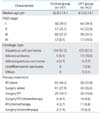1. Jemal A, Bray F, Center MM, Ferlay J, Ward E, Forman D. Global cancer statistics. CA Cancer J Clin. 2011; 61:69–90.
2. Fujii S, Kitano S, Ikenaka K, Shirasaka T. Effect of coadministration of uracil or cytosine on the anti-tumor activity of clinical doses of 1-(2-tetrahydrofuryl)-5-fluorouracil and level of 5-fluorouracil in rodents. Gan. 1979; 70:209–214.
3. Tanaka F, Fukuse T, Wada H, Fukushima M. The history, mechanism and clinical use of oral 5-fluorouracil derivative chemotherapeutic agents. Curr Pharm Biotechnol. 2000; 1:137–164.
4. Ikenaka K, Shirasaka T, Kitano S, Fujii S. Effect of uracil on metabolism of 5-fluorouracil in vitro. Gan. 1979; 70:353–359.
5. Wada H, Hitomi S, Teramatsu T. Adjuvant chemotherapy after complete resection in non-small-cell lung cancer. West Japan Study Group for Lung Cancer Surgery. J Clin Oncol. 1996; 14:1048–1054.
6. Kato H, Ichinose Y, Ohta M, Hata E, Tsubota N, Tada H, et al. A randomized trial of adjuvant chemotherapy with uracil-tegafur for adenocarcinoma of the lung. N Engl J Med. 2004; 350:1713–1721.
7. Nakagawa K, Tada H, Akashi A, Yasumitsu T, Iuchi K, Taki T, et al. Randomised study of adjuvant chemotherapy for completely resected p-stage I-IIIA non-small cell lung cancer. Br J Cancer. 2006; 95:817–821.
8. Kinoshita T, Nakajima T, Ohashi Y. National Surgical Adjuvant Study Group for Gastric Cancer. Adjuvant chemotherapy with uraciltegafur (UFT) for serosa negative advanced gastric cancer: results of a randomized trial by national surgical adjuvant study of gastric cancer. J Clin Oncol. 2005; 23:16 Suppl. 313S.
9. Nakajima T, Kinoshita T, Nashimoto A, Sairenji M, Yamaguchi T, Sakamoto J, et al. Randomized controlled trial of adjuvant uraciltegafur versus surgery alone for serosa-negative, locally advanced gastric cancer. Br J Surg. 2007; 94:1468–1476.
10. Akasu T, Moriya Y, Ohashi Y, Yoshida S, Shirao K, Kodaira S, et al. Adjuvant chemotherapy with uracil-tegafur for pathological stage III rectal cancer after mesorectal excision with selective lateral pelvic lymphadenectomy: a multicenter randomized controlled trial. Jpn J Clin Oncol. 2006; 36:237–244.
11. Noguchi S, Koyama H, Uchino J, Abe R, Miura S, Sugimachi K, et al. Postoperative adjuvant therapy with tamoxifen, tegafur plus uracil, or both in women with node-negative breast cancer: a pooled analysis of six randomized controlled trials. J Clin Oncol. 2005; 23:2172–2184.
12. Yamamoto K, Izumi R, Hasegawa K, Nakajima H, Ohashi K, Kudo R, et al. Adjuvant oral 5-fluorouracil for cervical cancer: Japanese Gynecologic Oncology Group report. Int J Oncol. 2004; 24:1175–1179.
13. Ho DH, Pazdur R, Covington W, Brown N, Huo YY, Lassere Y, et al. Comparison of 5-fluorouracil pharmacokinetics in patients receiving continuous 5-fluorouracil infusion and oral uracil plus N1-(2'-tetrahydrofuryl)-5-fluorouracil. Clin Cancer Res. 1998; 4:2085–2088.
14. Taguchi T, Ikeda Y, Mikami Y, Kawai S, Arai Y, Mochimatsu I, et al. Combined radiotherapy and chemotherapy with carboplatin and UFT for head and neck squamous cell carcinoma. Anticancer Res. 2003; 23(1B):713–717.
15. Ichinose Y, Yano T, Asoh H, Yokoyama H, Maruyama R, Ushijima C, et al. UFT plus cisplatin with concurrent radiotherapy for locally advanced non-small-cell lung cancer. Oncology (Williston Park). 1999; 13:7 Suppl 3. 98–101.
16. Cellier P, Leduc B, Martin L, Vie B, Chevelle C, Vendrely V, et al. Phase II study of preoperative radiation plus concurrent daily tegafururacil (UFT) with leucovorin for locally advanced rectal cancer. BMC Cancer. 2011; 11:98.
17. Lorvidhaya V, Chitapanarux I, Sangruchi S, Lertsanguansinchai P, Kongthanarat Y, Tangkaratt S, et al. Concurrent mitomycin C, 5-fluorouracil, and radiotherapy in the treatment of locally advanced carcinoma of the cervix: a randomized trial. Int J Radiat Oncol Biol Phys. 2003; 55:1226–1232.
18. Duenas-Gonzalez A, Zarba JJ, Patel F, Alcedo JC, Beslija S, Casanova L, et al. Phase III, open-label, randomized study comparing concurrent gemcitabine plus cisplatin and radiation followed by adjuvant gemcitabine and cisplatin versus concurrent cisplatin and radiation in patients with stage IIB to IVA carcinoma of the cervix. J Clin Oncol. 2011; 29:1678–1685.
19. Tanaka F, Yanagihara K, Otake Y, Miyahara R, Wada H. Angiogenesis and the efficacy of postoperative administration of UFT in pathologic stage I non-small cell lung cancer. Cancer Sci. 2004; 95:371–376.
20. Tanaka F, Otake Y, Yanagihara K, Kawano Y, Miyahara R, Li M, et al. Correlation between apoptotic index and angiogenesis in non-small cell lung cancer: comparison between CD105 and CD34 as a marker of angiogenesis. Lung Cancer. 2003; 39:289–296.
21. Tanaka F, Otake Y, Yanagihara K, Yamada T, Miyahara R, Kawano Y, et al. Apoptosis and p53 status predict the efficacy of postoperative administration of UFT in non-small cell lung cancer. Br J Cancer. 2001; 84:263–269.
22. Nakagawa T, Tanaka F, Takata T, Matsuoka K, Miyahara R, Otake Y, et al. Predictive value of dihydropyrimidine dehydrogenase expression in tumor tissue, regarding the efficacy of postoperatively administered UFT (Tegafur + Uracil) in patients with p-stage I nonsmall-cell lung cancer. J Surg Oncol. 2002; 81:87–92.
23. Nakano J, Huang C, Liu D, Masuya D, Nakashima T, Yokomise H, et al. Evaluations of biomarkers associated with 5-FU sensitivity for non-small-cell lung cancer patients postoperatively treated with UFT. Br J Cancer. 2006; 95:607–615.
24. Nagai N, Mukai K, Hirata E, Jin HH, Komatsu M, Yunokawa M. UFT and its metabolite gamma-butyrolactone (GBL) inhibit angiogenesis induced by vascular endothelial growth factor in advanced cervical carcinoma. Med Oncol. 2008; 25:214–221.










 PDF
PDF ePub
ePub Citation
Citation Print
Print


 XML Download
XML Download